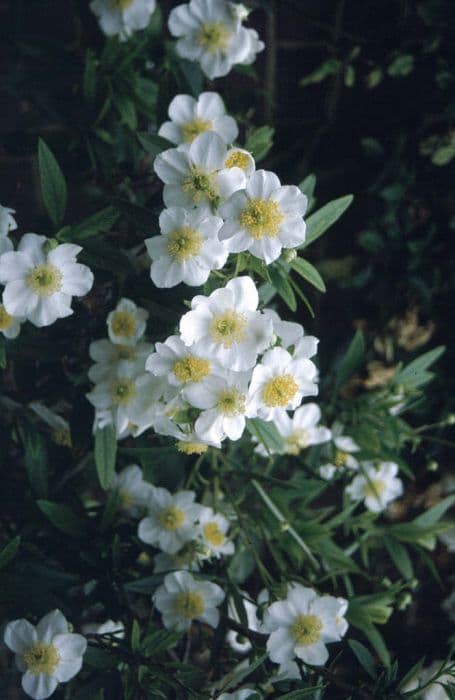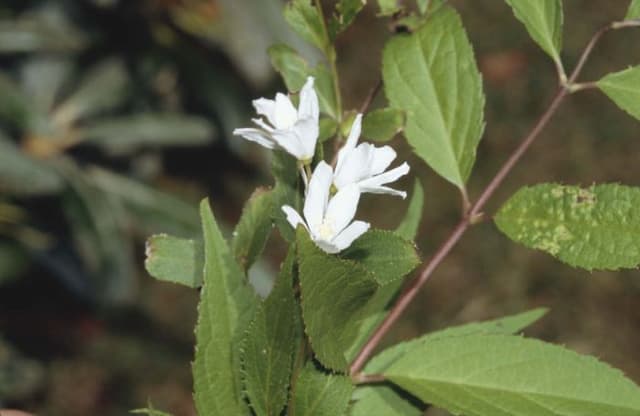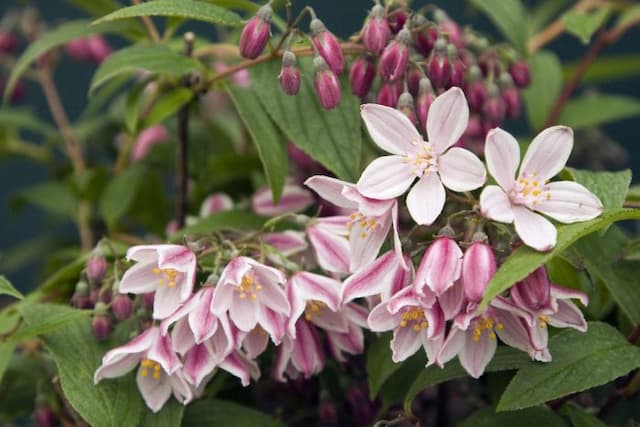Strawberry Fields Deutzia Deutzia × hybrida 'Strawberry Fields'

ABOUT
Deutzia 'Strawberry Fields' is a visually striking shrub known for its beautiful blooms. The flowers are star-shaped and have a rich pink color that fades to white at the base, giving them a two-tone effect. These flowers bloom in clusters along the branches, creating a dense and abundant display that can cover the shrub when in full bloom, giving it a showy and vibrant appearance. The plant's leaves are deciduous, meaning they fall off during the winter, and when present, they provide a lush backdrop of green against which the pink flowers stand out. The leaves are oval-shaped with finely serrated edges and a slight arch to their form, giving the plant an overall graceful and delicate look. The overall shape of the shrub is typically rounded or mounded, giving it a neat appearance in the landscape. Its stems are slender and may have a reddish tint, which adds to the aesthetic appeal of the plant, especially during the flowering season in spring and early summer.
About this plant
 Names
NamesFamily
Hydrangeaceae.
Synonyms
Strawberry Fields Deutzia, Hybrid Deutzia.
Common names
Deutzia × hybrida 'Strawberry Fields'.
 Toxicity
ToxicityTo humans
Deutzia 'Strawberry Fields' is not known to be toxic to humans. Therefore, there are no specific symptoms of poisoning associated with this plant. However, it is generally recommended to avoid ingesting any part of ornamental plants as they are not intended for consumption.
To pets
Deutzia 'Strawberry Fields' is not known to be toxic to pets. It is not typically associated with poisoning symptoms in animals. As with humans, ingestion of non-food plants should be discouraged, but accidental ingestion is unlikely to cause harm.
 Characteristics
CharacteristicsLife cycle
Perennials
Foliage type
Deciduous
Color of leaves
Green
Flower color
Pink
Height
4-5 feet (1.2-1.5 meters)
Spread
4-5 feet (1.2-1.5 meters)
Plant type
Shrub
Hardiness zones
5-8
Native area
East Asia
Benefits
 General Benefits
General Benefits- Attractive Blooms: Deutzia 'Strawberry Fields' offers abundant clusters of vibrant pink flowers that add a burst of color to any garden in spring.
- Wildlife Friendly: The blossoms attract various pollinators, including bees and butterflies, which contribute to the local ecosystem.
- Low Maintenance: Once established, Deutzia 'Strawberry Fields' is relatively low maintenance, requiring minimal care beyond occasional pruning and watering.
- Hardy Plant: It is quite hardy and can tolerate a range of soil conditions and climates, making it a robust choice for many gardens.
- Seasonal Interest: In addition to spring flowers, it offers seasonal interest with its foliage, which can change color in the fall.
- Compact Growth: This plant has a compact growth habit, making it suitable for smaller gardens or as part of a mixed border without overwhelming the space.
- Improves Garden Aesthetics: Deutzia 'Strawberry Fields' has a graceful appearance that can enhance the overall aesthetics of a garden design.
- Versatility: It can be used in a variety of garden settings, from informal cottage gardens to more formal landscape designs.
 Medical Properties
Medical PropertiesThis plant is not used for medical purposes.
 Air-purifying Qualities
Air-purifying QualitiesThis plant is not specifically known for air purifying qualities.
 Other Uses
Other Uses- Deutzia 'Strawberry Fields' can be used in photography and painting as a captivating subject due to its beautiful, dense clusters of pink and white flowers.
- The plant’s sturdy stems can be employed in light crafts, such as making small trellises for supporting other, less-stable plants.
- Dried flowers of Deutzia 'Strawberry Fields' may be included in potpourri mixes to add a natural, floral touch to home decor.
- The dense habit and foliage of the plant provide a hiding space for garden wildlife, such as beneficial insects and small birds.
- During festive seasons, its attractive blooms can be snipped and used as a fresh, natural garnish for plating and table arrangements.
- Deutzia 'Strawberry Fields' can be integrated into permaculture gardens as a companion plant, offering benefits such as mutual shading and support to neighboring plants.
- Educationally, the plant can be used in botany classes to teach about hybridization and ornamental plant breeding.
- In landscape design, the plant’s tiered branching pattern can be used to influence or contrast geometric arrangement in formal gardens.
- The plant can be used as a natural fence or border when planted in a row to provide privacy in residential garden spaces.
- Ecologically, Deutzia 'Strawberry Fields' can be part of biodiversity enhancement projects, serving to increase the variety of plant life in an area.
Interesting Facts
 Feng Shui
Feng ShuiStrawberry Fields Deutzia is not used in Feng Shui practice.
 Zodiac Sign Compitability
Zodiac Sign CompitabilityStrawberry Fields Deutzia is not used in astrology practice.
 Plant Symbolism
Plant Symbolism- Innocence: Deutzia flowers are often associated with purity and innocence due to their delicate and unassuming appearance.
- Humility: The modest nature of the plant, which does not grow very tall and has a graceful, understated beauty, symbolizes humility and discretion.
- Youthful charm: 'Strawberry Fields' with its vibrant color and fresh look reflects the liveliness and charm of youth.
- Self-discovery: The blooming of Deutzia can represent the blossoming of oneself and the journey of personal growth and discovery.
- Feminine beauty: Often, the soft, pink hues of the Deutzia 'Strawberry Fields' flowers stand for gentle feminine beauty and grace.
 Water
WaterStrawberry Fields Deutzia should be watered deeply but infrequently, ensuring that the soil is moist but not waterlogged. During the growing season, typically spring and summer, water the plant once a week with about 1 to 2 gallons per watering session, depending on the size of the plant and the weather conditions. In hot, dry periods, you may need to water more frequently, while in cooler, wet seasons, you can reduce watering. Always check the top inch of the soil for dryness before watering again. During winter, scale back watering to every few weeks, just enough to prevent the soil from completely drying out.
 Light
LightStrawberry Fields Deutzia thrives best in full sun to partial shade conditions. It should be placed in a spot where it can receive at least 4 to 6 hours of sunlight daily. Avoid deep shade locations, as this can impede the plant's flowering potential and overall health.
 Temperature
TemperatureStrawberry Fields Deutzia prefers moderate temperatures and can generally tolerate a range from about 20 degrees Fahrenheit in the winter to 90 degrees Fahrenheit in the summer. The ideal growing temperatures for this shrub are between 60 and 75 degrees Fahrenheit. It is important to protect the plant from extreme cold below 20 degrees Fahrenheit, as it can suffer from frost damage.
 Pruning
PruningPruning Strawberry Fields Deutzia is essential for maintaining its shape, encouraging new growth, and enhancing its flowering capacity. The best time to prune is right after the plant has finished flowering, usually late spring or early summer. Remove any dead or weak stems, and cut back about one-third of the old stems to ground level to promote new, vigorous growth. Pruning should be done annually.
 Cleaning
CleaningAs needed
 Soil
SoilStrawberry Fields Deutzia requires well-draining soil with a high organic matter content. The best mix would consist of loam, peat, and coarse sand to facilitate drainage. The soil pH preferred by this plant is slightly acidic to neutral, ranging from 6.0 to 7.0.
 Repotting
RepottingStrawberry Fields Deutzia does not need frequent repotting; it should be repotted every 3-5 years, or when it becomes root-bound. During repotting, use the chance to refresh the soil mix to ensure continued health and growth.
 Humidity & Misting
Humidity & MistingStrawberry Fields Deutzia thrives in average household humidity levels. While it can tolerate some humidity fluctuations, it does best when the air is not too dry, making it fairly easy to maintain in most home environments.
 Suitable locations
Suitable locationsIndoor
Provide bright indirect light and regular watering.
Outdoor
Choose a sunny spot, shield from strong winds, and mulch.
Hardiness zone
5-8 USDA
 Life cycle
Life cycleDeutzia 'Strawberry Fields' begins its life as a seed, which when sown, germinates to sprout seedlings that emerge from the soil. The seedlings grow into young plants that develop a root system and foliage. As the Deutzia plant matures, it enters a vegetative stage, where it grows actively and increases in size during the spring and summer months. The plant then forms buds, which lead to its flowering stage, typically in late spring to early summer, showcasing its vibrant pink blooms that attract pollinators. After pollination, the flowers may produce small, dry fruits containing seeds that can be dispersed to give rise to new plants. At the end of the growing season, Deutzia 'Strawberry Fields' enters a period of dormancy during the colder months, conserving energy and resources until the next cycle of growth in the spring.
 Propogation
PropogationPropogation time
Spring to Summer
Propogation: The most popular method of propagating Deutzia 'Strawberry Fields', a deciduous shrub known for its pink flowers, is through softwood cuttings. This typically takes place in late spring or early summer when new growth is still tender. To propagate, a healthy shoot is selected and a cutting approximately 4 to 6 inches long is taken. The lower leaves are removed, and the cut end is dipped in rooting hormone to encourage root development. The cutting is then inserted into a pot filled with a mix of peat and perlite or a similar well-draining rooting medium and is kept under high humidity and indirect light until roots have formed, which often takes a few weeks to a couple of months. During this time, the cutting must be kept moist but not waterlogged to prevent rot. Once rooted, the young plant can be gradually acclimatized to less humid conditions and eventually transplanted outdoors.







![Hydrangea [Strong Annabelle]](/_next/image?url=https%3A%2F%2Fplants-admin.emdemapps.com%2Fimages%2Fplants%2F%2Fimages%2F604b54db37d34.png&w=640&q=75)

